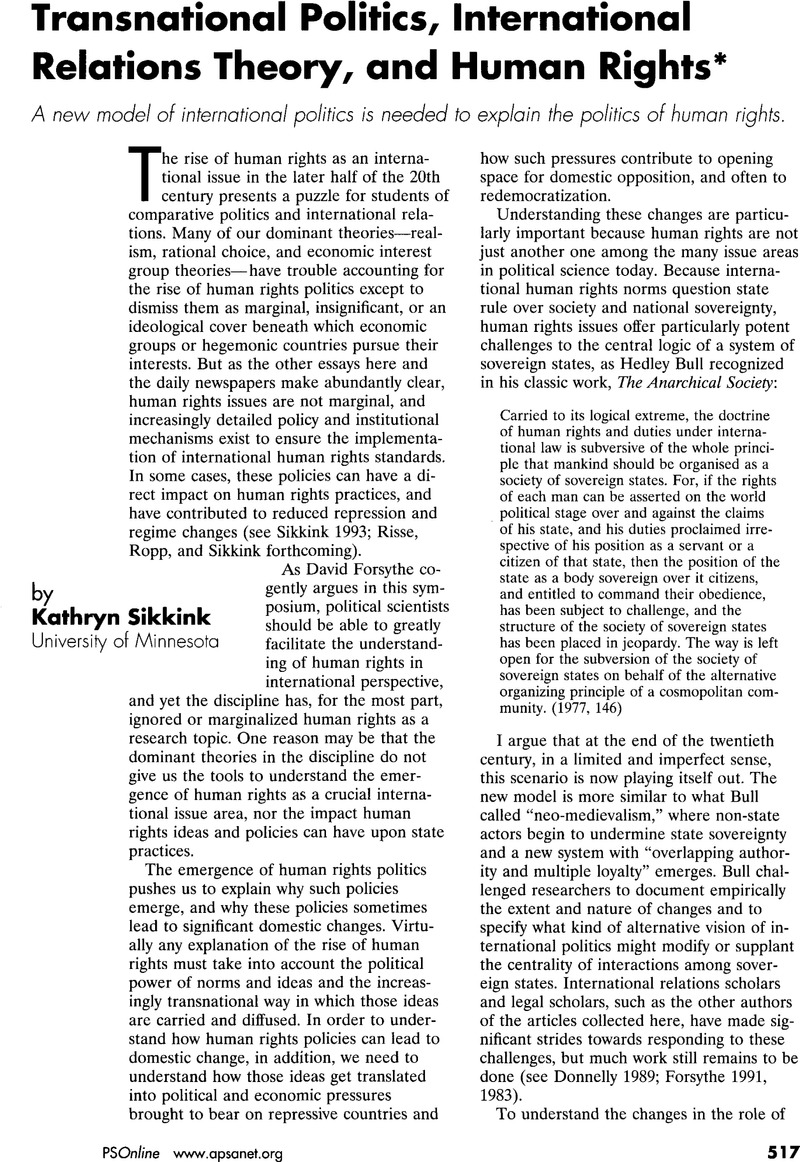Crossref Citations
This article has been cited by the following publications. This list is generated based on data provided by Crossref.
Michaud, Nelson
and
Belanger, Louis
2000.
Canadian Institutional Strategies: New Orientations for a Middle Power Foreign Policy?.
Australian Journal of International Affairs,
Vol. 54,
Issue. 1,
p.
97.
Lake, David A.
and
Wong, Wendy
2007.
The Politics of Networks: Interests, Power, and Human Rights Norms.
SSRN Electronic Journal,
Asal, Victor
Nussbaum, Brian
and
Harrington, D. William
2007.
Terrorism as Transnational Advocacy: An Organizational and Tactical Examination.
Studies in Conflict & Terrorism,
Vol. 30,
Issue. 1,
p.
15.
Montoya, Celeste
2008.
The European Union, Capacity Building, and Transnational Networks: Combating Violence Against Women Through the Daphne Program.
International Organization,
Vol. 62,
Issue. 02,
Cass, Loren R
2008.
A climate of obstinacy: symbolic politics in Australian and Canadian policy.
Cambridge Review of International Affairs,
Vol. 21,
Issue. 4,
p.
465.
Asher, Jana
2008.
Statistical Methods for Human Rights.
p.
3.
Waldman, Linda
2009.
‘Show me the Evidence’: Mobilisation, Citizenship and Risk in Indian Asbestos Issues.
IDS Working Papers,
Vol. 2009,
Issue. 329,
p.
01.
Gilligan, Michael J.
and
Nesbitt, Nathaniel H.
2009.
Do Norms Reduce Torture?.
The Journal of Legal Studies,
Vol. 38,
Issue. 2,
p.
445.
Holzhacker, Ronald
2009.
The Transnationalization of Economies, States, and Civil Societies.
p.
219.
2012.
The Wiley‐Blackwell Companion to Political Sociology.
p.
491.
Meier, Benjamin Mason
Kayser, Georgia Lyn
Kestenbaum, Jocelyn Getgen
Amjad, Urooj Quezon
Dalcanale, Fernanda
and
Bartram, Jamie
2014.
Translating the Human Right to Water and Sanitation into Public Policy Reform.
Science and Engineering Ethics,
Vol. 20,
Issue. 4,
p.
833.
Tryggestad, Torunn L
2014.
State feminism going global: Norway on the United Nations Peacebuilding Commission.
Cooperation and Conflict,
Vol. 49,
Issue. 4,
p.
464.
Figari Layús, Rosario
2015.
Handbuch Transitional Justice.
p.
1.
Tang, Shiping
2015.
The Reaches of the International System: Six Channels.
SSRN Electronic Journal,
Stavrianakis, Anna
2016.
Legitimising liberal militarism: politics, law and war in the Arms Trade Treaty.
Third World Quarterly,
Vol. 37,
Issue. 5,
p.
840.
Ayala, Ana
and
Meier, Benjamin Mason
2017.
A human rights approach to the health implications of food and nutrition insecurity.
Public Health Reviews,
Vol. 38,
Issue. 1,
Conlon, John J.
2017.
Major Malfunction: A Field Experiment Correcting Undergraduates' Beliefs about Salaries.
SSRN Electronic Journal ,
Ayala, Ana Sumei
and
Meier, Benjamin Mason
2017.
A Human Rights Approach to the Health Implications of Food and Nutrition Insecurity.
SSRN Electronic Journal,
Figari Layús, Rosario
2018.
Handbuch Transitional Justice.
p.
431.
Rios, Francisco
2018.
The legacy and trajectories of multicultural education: recognition, refusal, and movement building in troubling times.
Multicultural Education Review,
Vol. 10,
Issue. 3,
p.
165.



